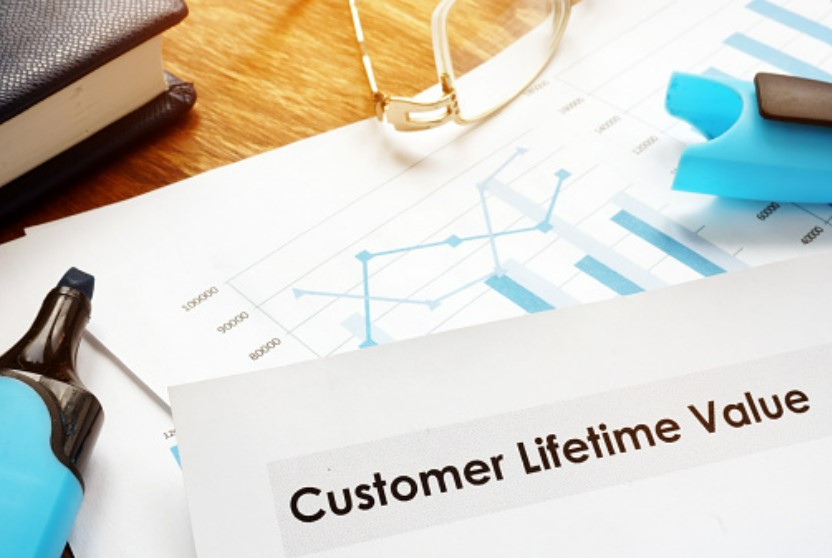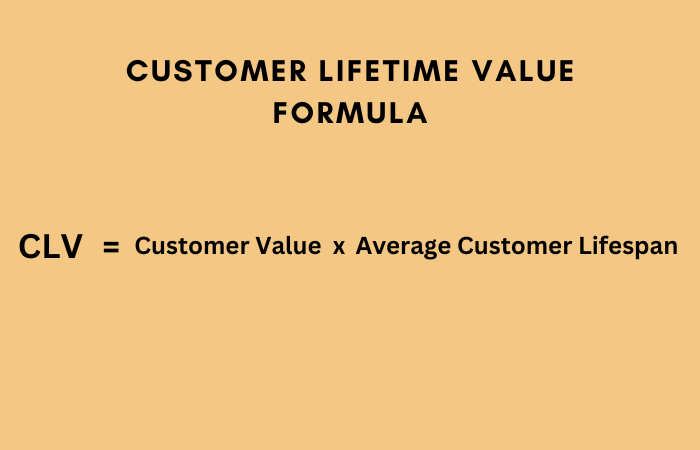
What is Customer Lifetime Value (CLV)?
Customer Lifetime Value (CLV) is the worth of a customer over their whole time using the business. It’s about more than just the first buy, but also whether they’ll keep returning to purchase more.
Companies examine how much money customers spend, how frequently they purchase, and how long they stay as a customer to calculate CLV. This helps determine potential future earnings.
CLV is crucial for businesses to understand because it helps prioritize customer service efforts. If a customer has a high CLV, the company might focus on building a solid relationship with them.
Suppose a company figures out how much each customer will spend in the long run. In that case, businesses can use this method to advertise and close deals.
To make CLV work for them, businesses should seek to give customers first-class experiences, such as top-tier customer service, tailored messages, and an effortless purchasing procedure.
Understanding CLV is vital for companies that want to keep customers returning, leading to more success and revenue.
How to Calculate Customer Lifetime Value?
CLV is a critical way to know if your business will make a profit in the long run. You determine how much a customer is worth over their relationship with your business.
Knowing this lets you tell which customers are worth putting more time and money into. To figure out CLV, follow this formula that looks at a few things.
First, you have to know how much money each customer usually spends (APV, Average Purchase Value), then how often they buy (PF, Purchase Frequency), and how long they stick around (ACL, Average Customer Lifespan).
Once you have collected these three essential details, you can find the Customer Lifetime Value (CLV) using this formula:
Customer Lifetime Value = Average Purchase Value x Purchase Frequency x Average Customer Lifespan
CLV = APV x PF x ACL
or
Customer Lifetime Value = Customer Value x Average Customer Lifespan
CLV = CV x ACL
Download the CLV calculator template by HubSpot.
Take, for example, a coffee shop owner who wants to estimate the CLV of one of their frequent customers.
Upon analyzing their buying patterns, the owner discovers that the customer typically spends $5(APV=$5) on a coffee and a pastry thrice a week (PF=3) and has been a regular for two years (ACL=2).
Applying the formula, the coffee shop owner can calculate the Customer’s CLV to be $30.
In other words, the customer is expected to spend $30 at the coffee shop over the next two years. By crunching the numbers on each client, you can figure out who’s worth the most to your business.
Plus, you can check out chances to boost your average sale or profits per customer to get everyone’s CLV up.
Customer Lifetime Value Metrics
Some metrics you should know while calculating CLV:
1. Average Purchase Value (APV) or Average Order Value (AOV)
To calculate Average Purchase Value (APV) or Average Order Value (AOV), divide the company’s total revenue by the number of orders made.
APV = Total Revenue / Number of Orders
2. Purchase Frequency (PF) or Average Purchases Frequency Rate (APFR)
These measures how often, on average, customers purchase from you during a particular time frame.
You can calculate it by dividing the number of orders by the number of unique customers.
PF = Total Number of Orders / Number of Unique Customers
3. Customer Value (CV)
This metric is the total amount of money a customer spends with you throughout their entire relationship with your business.
Calculate it by multiplying the Average Purchase Value (APV) by the Purchase Frequency (PF).
CV = APV x PF
4. Average Customer Lifespan (ACL)
This metric is how long a customer will stay a customer.
To calculate this, divide the sum of customer lifespan by the number of customers.
ACL = Sum of Customer Lifespan / Number of Customers
Understanding the value of customers and analyzing the associated metrics is crucial for businesses aiming to enhance their customer acquisition and retention strategies.
Discover more strategies for customer retention.
By keeping track of these metrics, companies can make informed decisions about assigning resources and making investments, ultimately boosting revenue and profit.
Why does Customer Lifetime Value Matter?
It’s an essential factor for businesses of all sizes because it helps them understand the worth and potential of their customer base.
1. Knowing Customer Worth
The CLV enables businesses to determine how much each customer is worth. This helps them make knowledgeable choices about using their resources and prioritize customer acquisition and retention.
By focusing on customers who bring in the most revenue, companies can increase their return on investment and improve customer satisfaction.
2. Predicting Future Income
Businesses can use the CLV to forecast future revenue by examining past customer behavior.
This allows businesses to prepare for future expansion and make strategic choices about product development, advertising campaigns, and customer service improvements.
3. Spotting Opportunities for Growth
The CLV can detect chances to grow the business by increasing customer spending or enhancing retention rates.
For example, suppose a company sees a group of high-value customers not using a specific product or service. In that case, they can target them with appropriate marketing campaigns or incentives to try the product.
4. Making Customers Happy
Businesses can make customers more satisfied by concentrating on the total value that they bring.
By getting to know their customer base’s worth and potential, businesses can customize their goods and services to suit their customer’s desires and preferences.
This might make clients more loyal and satisfied with their dealings.
Customer Lifetime Value is vital for firms striving to thrive and prosper in an increasingly competitive business climate.
By getting their customers’ value, businesses can make wise decisions about distributing resources, prioritize customer retention and acquisition attempts, and anticipate long-term expansion.
Ultimately, businesses focusing on CLV are better positioned to enhance customer satisfaction and raise revenue.
Tips to Increase Customer Lifetime Value
By improving CLV, a company can make more money.
Here’s how you can do it:
1. Treat Customers Like Royalty
Giving top-notch service is a great way to improve CLV. If you go out of your way to make customers happy, they’ll likely return and spend more money.
2. Make It Personal
Personalization is essential too. If you tailor your offerings and services to customers’ preferences, they will likely become loyal repeat customers.
3. Sell More Products
Suggesting additional products or services is an excellent way to increase CLV. But please, don’t be too intrusive or make customers feel like they’re being tricked.
Make sure to set up a rewards system to keep customers coming back for more. Offering incentives and bonuses to returning buyers is a great way to show appreciation and encourage them to stay loyal to your business.
Remember to keep your current customers happy and engaged so they don’t leave for the competition. You can do this by giving them lasting value and special deals and engaging with them on social media.
Conclusion
Customer Lifetime Value is crucial for any business wanting to succeed. To make it happen, prioritize customer satisfaction, personalize their experiences, use upselling and cross-selling tactics, implement a loyalty program, and focus on retention.
This way, you’ll see your revenue and profitability go up.

Vijay Kumar is a digital marketing expert and founder of TechZant.
He is passionate about helping businesses grow their online presence through SEO and data-driven strategies.




